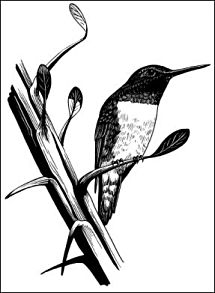
In many bird species, the sexes cooperate to rear the next generation. Not the Black-chinned Hummingbird, a common nesting species in the southwestern deserts of the United States.
The males are first to fly north in the spring, setting up a territory with food and roosting sites. On arrival, a female establishes her own territory, consisting of the nest site, perches, feeding grounds, and a mating area. She constructs a small nest of bark, flower and leaf fragments, often held together with spider webs. Occasional visits to the mating area entice the male to show off. He performs impressive aerial displays complete with calls, feather-produced trills, and whizzing dives to win his mate. Soon after, the female lays and incubates two eggs—alone, for the male retires to his territory.
The young leave the nest after about 35 days of care by the female. The
parents then begin separate trips south, leaving the young to find their own way to the
 Mexican wintering grounds. So
much for parental guidance in the world of hummingbirds!
Mexican wintering grounds. So
much for parental guidance in the world of hummingbirds!
Listen to the Audio (mp3 format) as recorded by KTEP, Public Radio for the Southwest.
Contributor: Scott M. Cutler, Centennial Museum, University of Texas at El Paso.
Desert Diary is a joint production of the Centennial Museum and KTEP National Public Radio at the University of Texas at El Paso.

Black-chinned Hummingbird. Drawing © 1999 by Zackery Zdinak.
Bent, A. C. 1964. Life Histories of North American Cuckoos, Goatsuckers, Hummingbirds and Their Allies. Dover.
Johnsgard, P.A. 1983. The Hummingbirds of North America. Smithsonian Institution Press, Washington, D.C.
Peterson, J., and B. R. Zimmer. 1998. Birds of the Trans Pecos. University of Texas Press, Austin, 184 pp.
Southeastern Arizona Bird Observatory.